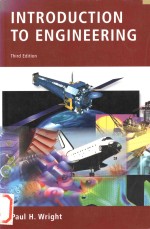图书介绍
Introduction to engineeringPDF|Epub|txt|kindle电子书版本网盘下载

- Paul H. Wright 著
- 出版社: Wiley
- ISBN:047105920X
- 出版时间:2002
- 标注页数:276页
- 文件大小:103MB
- 文件页数:289页
- 主题词:
PDF下载
下载说明
Introduction to engineeringPDF格式电子书版下载
下载的文件为RAR压缩包。需要使用解压软件进行解压得到PDF格式图书。建议使用BT下载工具Free Download Manager进行下载,简称FDM(免费,没有广告,支持多平台)。本站资源全部打包为BT种子。所以需要使用专业的BT下载软件进行下载。如BitComet qBittorrent uTorrent等BT下载工具。迅雷目前由于本站不是热门资源。不推荐使用!后期资源热门了。安装了迅雷也可以迅雷进行下载!
(文件页数 要大于 标注页数,上中下等多册电子书除外)
注意:本站所有压缩包均有解压码: 点击下载压缩包解压工具
图书目录
CHAPTER 1 /HISTORY OF ENGINEERING1
1.1 Introduction1
1.2 Engineering in the Early Civilizations: The Mesopotamians2
1.3 Engineering in the Early Civilizations: The Egyptians3
1.4 Contributions of the Greeks6
1.5 Contributions of the Romans7
1.6 Engineering in the Middle Ages10
1.7 The Advancement of Science: Circa A.D.1300-175010
1.8 Advancements in Engineering: A.D.1750-190011
1.9 Engineering in the Twentieth Century14
CHAPTER 2/DEFINITION OF ENGINEERING21
2.1 Engineering21
2.2 Engineering Support Personnel23
ENGINEERING FIELDS OF SPECIALIZATION25
2.3 Electrical Engineering25
2.4 Computer Engineering26
2.5 Mechanical Engineering27
2.6 Civil Engineering28
2.7 Chemical Engineering30
2.8 Industrial Engineering31
2.9 Aerospace Engineering32
2.10 Materials Engineering32
2.11 Other Branches of Engineering33
2.12 Functions of Engineering34
CAREER PATHS FOR ENGINEERS35
2.13 The Corporate Ladder36
2.14 The Independent Entrepreneur37
2.15 Employment Opportunities in Government38
2.16 Engineering and Social Services Abroad39
2.17 The Engineering Professor39
2.18 Graduate Work Outside of Engineering40
2.19 The Multiple-Track, Variable Career41
INITIAL CAREER PROFILES41
2.20 Chemical Engineering Graduates42
2.21 Civil Engineering Graduates43
2.22 Electrical Engineering Graduates44
2.23 Mechanical Engineering Graduates45
2.24 Biomedical Engineering Graduates47
2.25 Computer Engineering Graduates47
2.26 Environmental Engineering Graduates48
2.27 Industrial Engineering Graduates48
CHAPTER 3/THE ENGINEER AS A PROFESSIONAL51
3.1 Engineering as a Profession51
3.2 Characteristics and Responsibilities of Professional Engineers53
3.3 Ideals and Obligations of Professional Engineers53
3.4 Professional Registration55
3.5 Professional Organizations57
3.6 Engineering Ethics60
3.7 Moral Foundations of Engineering Ethics61
3.8 The Framework of Engineering Ethics63
3.9 Codes of Engineering Ethics64
3.10 Case Studies in Engineering Ethics69
CHAPTER 4/LEARNING AND CREATIVE THOUGHT87
4.1 Introduction87
4.2 The Successful Engineering Student87
4.3 The Engineering Curriculum89
4.4 Curriculum Planning and Management93
4.5 Adapting to the College Classroom94
THE LEARNING PROCESS95
4.6 The Nature of Learning95
4.7 Information Processing and Memory95
4.8 Determinants of Efficient Learning97
4.9 Practical Suggestions for Learning98
DIFFERENCES IN THE WAY PEOPLE THINK99
4.10 The Four-Quadrant Model of Thinking99
4.11 Hindrances to Problem Solving101
ON CREATIVITY104
4.12 What Is Creativity?104
4.13 The Nature of Creativity104
4.14 Characteristics of Creative People105
4.15 The Creative Process106
4.16 Overcoming Obstacles to Creative Thinking106
CHAPTER 5/THE ENGINEERING APPROACH TO PROBLEM SOLVING111
THE NATURE OF ENGINEERING DESIGN111
Engineering Teams112
THE ENGINEERING METHOD112
5.1 Identification of the Problem113
5.2 Gathering Needed Information114
5.3 Searching for Creative Solutions114
Brainstorming115
Checklists115
Attribute Listing115
Forced Relationship Technique116
Morphological Analysis117
5.4 Stepping from Ideation to Preliminary Designs118
Mathematical Models119
Simulation Models119
Physical Models120
5.5 Evaluation and Selection of Preferred Solution125
Economic Analysis126
Other Evaluation Techniques128
5.6 Preparation of Reports, Plans, and Specifications130
5.7 Implementation of the Design130
Patenting130
Computer-Aided Design131
Learning from Failures132
The Hyatt Regency Hotel Walkways Collapse134
CHAPTER 6/ENGINEERING COMMUNICATIONS141
6.1 Introduction141
6.2 Communications and Information Resources142
How Engineers Find Information and the Information Seeking Process142
Turning Information into Knowledge:Evaluating and Processing Information142
Where to Locate Information and Good Starting Points145
THE ENGINEER AS A WRITER147
6.3 Guidelines for Effective Writing148
6.4 Types of Engineering Writing149
GRAPHICAL COMMUNICATIONS153
6.5 ANSI Line Conventions and Lettering155
6.6 Types of Graphical Communications158
6.7 Sketching158
6.8 Pictorial Representations159
6.9 Orthographic Representations160
6.10 Section Views161
6.11 Auxiliary Views163
6.12 Computer Tools for Creating Representations164
6.13 Simulation and Virtual Reality165
THE ENGINEER AS A SPEAKER165
6.14 Guidelines for Effective Speaking165
6.15 Use of Visual Aids166
Use of Computer Technology in Oral Presentations167
6.16 Technical Presentations at Professional Meetings167
6.17 The Engineer as a Presiding Officer168
CHAPTER 7/ENGINEERING CALCULATIONS175
7.1 The Presentation of Engineering Calculations175
7.2 Number Systems177
7.3 Dimensions178
7.4 Units179
The International System of Units180
Units Used with SI184
7.5 Significant Figures187
7.6 Scientific Notation188
BRANCHES OF MATHEMATICS188
7.7 Algebra189
7.8 Geometry189
7.9 Trigonometry190
7.10 Calculus191
7.11 Engineering Statistics194
The Normal Distribution196
7.12 Graphical Analysis199
Developing an Equation for a Straight-line Relationship202
CHAPTER 8/A CASE STUDY—ATLANTA'S FREEDOM PARKWAY PROJECT213
8.1 Background213
8.2 Social and Environmental Legislation214
8.3 Significant State Legislation217
8.4 The Abandonment of Interstate Route I-485218
8.5 Local Plan Development219
8.6 The Presidential Parkway221
Solicitation of Support222
Design Features and Location222
Social and Environmental Assessment226
Public Opposition to the Presidential Parkway227
Administrative Actions228
8.7 Litigation229
Civil Disobedience230
8.8 Mediation232
8.9 The Freedom Parkway235
Design Features of the Freedom Parkway238
Congressional Approval238
8.10 Conclusion238
CHAPTER 9/A CASE STUDY—THE SPACE SHUTTLE CHALLENGER ACCIDENT243
9.1 Background243
9.2 The Space Shuttle244
9.3 From Earth to Orbit246
9.4 Events Leading up to the Challenger Mission248
9.5 Launch Delays249
9.6 The Presidential Commission and Its Activities251
9.7 The Accident253
9.8 The Cause of the Accident257
9.9 The Contributing Cause of the Accident264
INDEX273